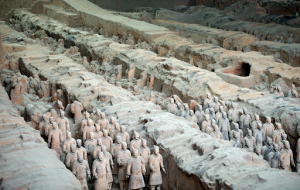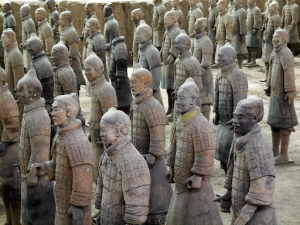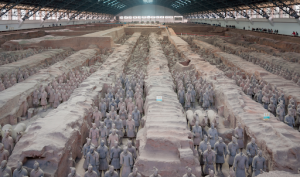Mysteries, Oddities, and Everything Strange: Terracotta Army
December 23, 2022
Terracotta Army: The Stone Soldiers
China is a staple in 9th grade world history classes. Everyone learned about the dynasties, the Silk Road, and China’s rise to power on a global scale. One of the most famous mysteries of ancient China is the collection of thousands of terracotta soldiers poised to defend a tomb. The Terracotta Army, as they are called nowadays, has been an enigma of ancient China and studied for almost 50 years. Despite the shroud of mystery, these statues can give us an enigmatic glimpse into worlds lost to history and teach us about a life completely separate from our own.
 The Terracotta Army was constructed for Qin Shi Huang, the first emperor of a unified China, and was built to represent his army. The statues surround his tombstone and face outward, as if to protect him. This gesture was meant to defend Qin as he entered the afterlife, allowing his army to remain by his side even after his passing. The various statues depict horses, soldiers, chariots, acrobats, and even musicians. The tallest consisted of generals and other important figures in the sea of stone-faced figures. It is estimated that there are about 9,000 soldiers in total that swarm Qin’s resting place.
The Terracotta Army was constructed for Qin Shi Huang, the first emperor of a unified China, and was built to represent his army. The statues surround his tombstone and face outward, as if to protect him. This gesture was meant to defend Qin as he entered the afterlife, allowing his army to remain by his side even after his passing. The various statues depict horses, soldiers, chariots, acrobats, and even musicians. The tallest consisted of generals and other important figures in the sea of stone-faced figures. It is estimated that there are about 9,000 soldiers in total that swarm Qin’s resting place.
Qin began the construction of this army when he first sat on the throne at 13 years old in 246 BC. His tomb was very complex in nature, constructed in a place full of natural resources and stuffed with plenty of priceless objects. There are various traps and obstacles to prevent potential looters or others intent on destruction. Overall, the tomb is a marvel of construction and it seems impossible that it could have been constructed over 2,000 years ago. Regardless, the combined work of over 700,000 laborers across multiple decades managed to pull together this marvel of engineering.
 The figures in the collection range from 5 feet 9 inches to about 6 feet 7 inches and their hair, clothing, and appearance are dependent upon their rank and role. There were various facial structures designated to each echelon of soldiers, including armored and unarmored infantry, chariot riders, and crossbow wielders. The armor of each individual statue also underwent some form of variation, with shin pads in different places or plating falling on the body in a different manner. The statues evidently had some sort of color when they were first created, including all the shades of the rainbow, but this artistry wore off quickly due to the weather and conditions of the place the statues were stored in.
The figures in the collection range from 5 feet 9 inches to about 6 feet 7 inches and their hair, clothing, and appearance are dependent upon their rank and role. There were various facial structures designated to each echelon of soldiers, including armored and unarmored infantry, chariot riders, and crossbow wielders. The armor of each individual statue also underwent some form of variation, with shin pads in different places or plating falling on the body in a different manner. The statues evidently had some sort of color when they were first created, including all the shades of the rainbow, but this artistry wore off quickly due to the weather and conditions of the place the statues were stored in.
The statues were constructed by creating each piece of the body individually and eventually assembling it. Designated construction workers and other artisans sculpted these masterpieces before they were carefully aligned in the tomb according to their viability and rank. Clay and molds were used to assure precision and detail in the faces. The statues also possessed real deadly weapons at one point, but these blades were either stolen or degraded due to time. The recovered materials were made of a mix of materials, like copper, tin, and magnesium. Complex techniques like the use of chromium dioxide increased the strength of the weapons and displayed ancient China’s strength and military prowess.
 The statues were discovered in 1974 by a handful of farmers in Central Eastern China in a place known as Lintong County. This place rested near Xi’an, Shaanxi, China in a mountain known as Mount Li. The geography was deliberately chosen for these statues due to its beautiful surroundings and plentiful natural resources. The Terracotta statues were a wonderful accomplishment for the ancient Chinese people and still are a wonder today. How could a civilization 2,000 years ago without any form of technology or sophisticated machinery be able to craft almost ten thousand identical statues with intricate details? The world might never know.
The statues were discovered in 1974 by a handful of farmers in Central Eastern China in a place known as Lintong County. This place rested near Xi’an, Shaanxi, China in a mountain known as Mount Li. The geography was deliberately chosen for these statues due to its beautiful surroundings and plentiful natural resources. The Terracotta statues were a wonderful accomplishment for the ancient Chinese people and still are a wonder today. How could a civilization 2,000 years ago without any form of technology or sophisticated machinery be able to craft almost ten thousand identical statues with intricate details? The world might never know.
The Terracotta Army is a UNESCO World Heritage Site, which means it is protected under their policies and will be designated as a natural wonder. The statues will continue to live on, free from any human interference that might come from curious tourists or annoying teenagers. Regardless, the mystery of the Terracotta Army is not as significant as other natural phenomena, but its origins and sheer scale make it a respectable artifact of time.
Resources:
https://en.wikipedia.org/wiki/Terracotta_Army
https://www.smithsonianmag.com/history/terra-cotta-soldiers-on-the-march-30942673/





















































